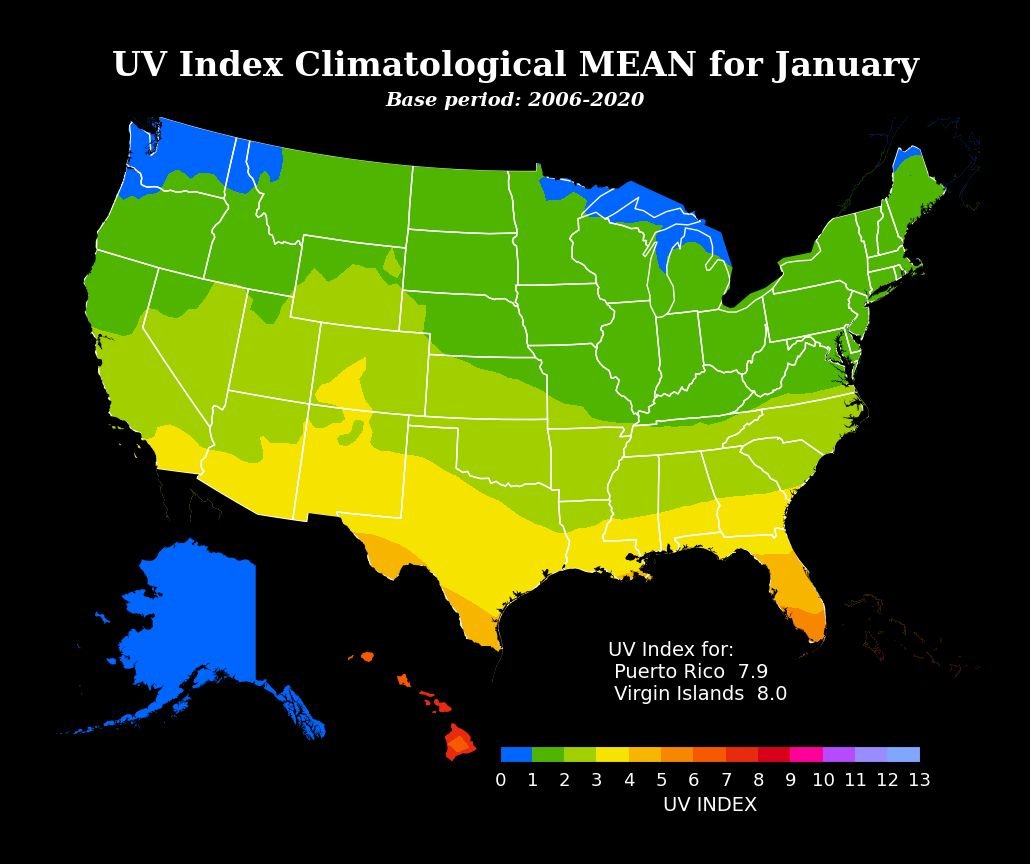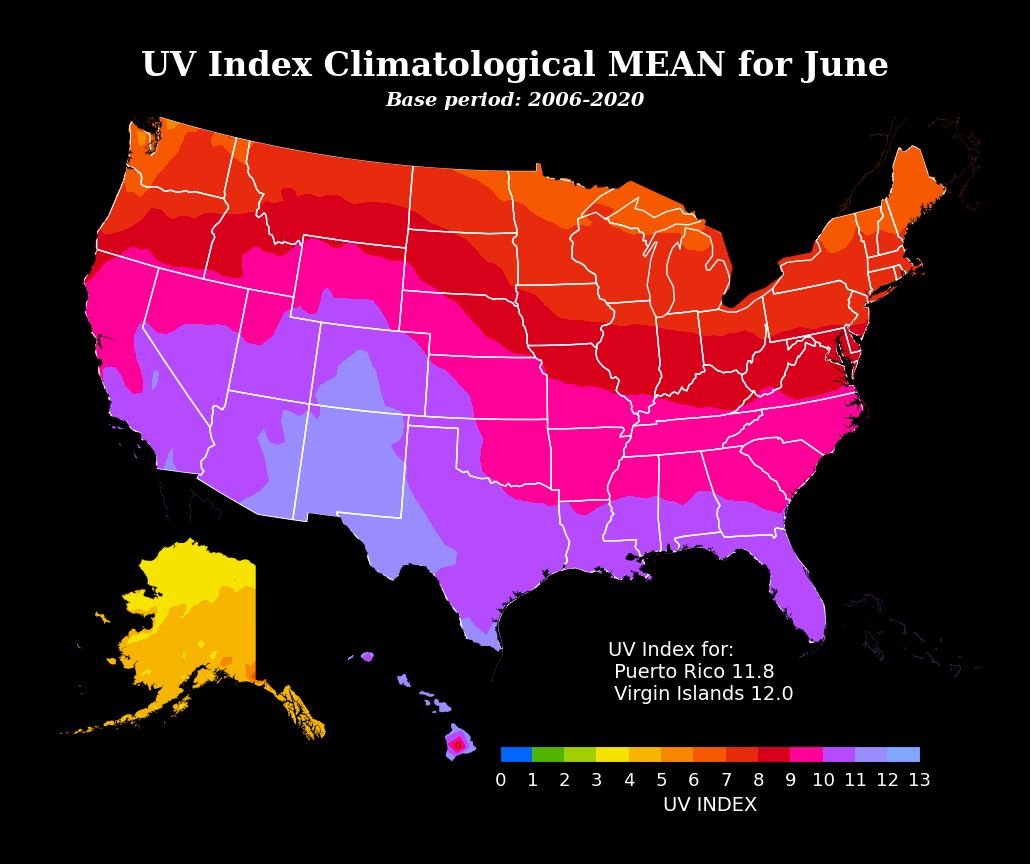Understanding the UV Index
Ultraviolet radiation is responsible for sunburns, skin aging, and it is the number one risk factor for skin cancers such as basal cell carcinoma, squamous cell carcinoma, and melanoma. The easiest way to minimize UV damage is to reduce UV exposure. The UV Index provides a beneficial resource to maximize fun outdoors while staying protected.
The UV Index Scale
The UV Index is displayed on a scale from 0 to 11+. As the numbers increase, so does your risk of getting a sunburn. An index of 0 indicates no UV radiation, as is essentially the case at night. An index of 11+, on the other hand, corresponds to midday summer sunlight with a clear sky. (Soure: Wikipedia) The UV Index levels are grouped into five exposure levels, which are explained below.
As recommended by the World Health Organization (WHO), UV Indexes are standardized globally. In the US, the UV Index is reported by the National Weather Service (NWS) and Environmental Protection Agency (EPA). For a global UV Index map, visit GRID-Arendal, a non-profit environmental communications center sponsored by the United Nations Environment Program (UNEP).
Low exposure (0-2) indicates minimal danger from the sun’s harmful rays, e.g. in the early mornings and evenings. It is safe to stay outside, but recommended to still use sunscreen, especially if you burn easily.
Moderate exposure (3-5) means low risk of harm from unprotected sun exposure for the average person. If you spend long periods of time outside, take precautions such as covering up and wearing sunscreen.
High exposure (6-7) indicates that protection against sunburn is needed. Reduce time in the sun between 11am and 4pm, especially if you’re fair-skinned. Wear protective clothing and sunglasses, and remember to apply sunscreen to sensitive areas like the nose, lips, and rims of the ears.
Very high exposure (8-10) means that unprotected skin will burn quickly. Seek shade, especially around noon. And don’t forget that surfaces like water, bright sand, or snow can reflect UV rays, amplifying their harmful effects.
Extreme exposure (11+) means a very high risk of harm from sun exposure. Unprotected skin can burn within minutes. Avoid being in the sun as much as possible and take all other precautions.
“Tip: Take a look at your shadow! Since the UV Index fluctuates throughout the day, peaking at noon, pay close attention to your shadow. The shorter your shadow, the higher your UV exposure if you stay in the sun.”
Why does the UV Index vary?
The intensity of the sun’s UV rays reaching the earth’s surface varies depending on a few factors, e.g. time of the year, time of the day, your physical location, and the weather conditions. All of these factors also affect the UV Index ratings.
Read our latest blog article: Frequently Asked Questions on UV Radiation
In the US, different parts of the country have different degrees of variation in the UV Index. For example, in Portland, Oregon, the average UV Index value during midday in winter is 1 (Low) whereas in Phoenix, Arizona it is 3 (Moderate). In summer, Portland’s midday average is 5 (Moderate) whereas in Phoenix, it is 10-11+ (Very high to extreme).
Image Source: https://www.epa.gov/sunsafety/sun-safety-monthly-average-uv-index
How to find out about the UV Index where you live
Since UV Index levels can vary greatly, it is important to stay informed. In many countries the UVI is reported along with the weather forecast in newspapers, on TV and on the radio. If you have an iPhone, check your Weather app, which comes preinstalled and indicates the current UV Index for all saved locations.
Project Sunscreen offers a free UV Index search tool to check your local UVI for up to three days, and the United States EPA has developed a free smartphone app that provides a daily forecast of the expected intensity of UV radiation from the sun.
We're here for you. If you have questions or would like to schedule an appointment, please call our office at 720.316.8091 or visit our Contact Page.
Frequently Asked Questions on UV Radiation
Image by Retha Ferguson
Understanding ultraviolet (UV) radiation and how it damages the skin, is an important first step in learning how to safeguard yourself against skin cancer. In this blog article, we’ve answered your most frequently asked questions about UV radiation and how to protect yourself.
What Is UV Radiation?
Ultraviolet (UV) radiation is a form of electromagnetic radiation emitted by the sun. UV rays are classified into three primary types based on the measure of their wavelength.
UVA rays have the longest wavelength and are not absorbed by the earth’s ozone layer. Prolonged exposure to UVA rays can cause skin cells to age leading to long-term skin damage such as wrinkle formation (photoaging). More recent studies suggest that UVA rays can also play a role in skin cancer because just like UVB rays, they provoke damage to the cells’ DNA (Source: Bulletin de L'Académie Nationale de Médecine 2014).
UVB rays have a shorter wavelength and are mostly absorbed by the earth’s ozone layer. These rays can damage the outermost layers of skin and are primarily responsible for sunburns. Unlike UVA rays, they are largely blocked by windows and are more likely to be filtered by clouds. UVB rays are considered the primary risk factor for development of skin cancer (Soure: World Health Organization 2006).
UVC rays have the shortest wavelength and are completely filtered out by the earth’s ozone layer. As a result, these rays never reach the ground. The only way that you can be exposed to UVC radiation is from an artificial source like welding torches, special bacteria-killing light bulbs, and mercury lamps. Although they are not considered a risk factor for skin cancer, UVC rays can cause severe damage to human eyes and skin including burns.
“UVB rays are felt to be the primary driver of skin cancers derived from ultraviolet light exposure. UVA rays penetrate deeper into the skin where the collagen resides and are associated with the development of wrinkles secondary to collagen loss. However, both UVA and UVB exposure can lead to the development of skin cancer so it is important to use a broad-spectrum sunscreen that blocks both UVA and UVB.”
Does Where I Live Affect the Amount of UV Radiation I Am Exposed to?
A number of environmental factors can affect how much UV you are exposed to. Some of these factors include:
Time of the year: UV rays are strongest in the spring and summer months. During these seasons, the sun is at a higher angle, which increases UV ray intensity. However, UV damage can still occur during fall and winter.
Time of the day: UV radiation is most intense around noon (between 10am and 4pm) when the sun is at its highest point in the sky.
Latitude: UV rays are strongest in areas surrounding the equator for two reasons. First, the angle of the sun at the equator allows rays to travel a shorter distance before they reach the ground. And second, the ozone layer in these areas is naturally thinner. Therefore, less UV rays are absorbed.
Altitude: UV rays are more powerful at higher elevations because they have to travel a shorter distance.
Read our latest blog article: High Elevation and 300 days of sunshine per year put Coloradans at risk
Weather conditions: Clouds can prevent UVB rays from reaching the ground. However, UVA rays are rarely affected and can still reach the skin on cloudy days.
Are There Health Benefits to UV Exposure?
Exposure to UV radiation can have certain health benefits, most importantly the way we metabolize vitamin D, which plays an important role in bone and muscle health. However, the American Association of Dermatology (ADD) advises against sun exposure or tanning beds as a mechanism to improve vitamin D levels. Instead, follow a healthy diet that includes foods that are natural sources of vitamin D including fatty fish like salmon and tuna (Source: American Association of Dermatology).
In addition, UV radiation in the form of lasers and lamps (phototherapy) can be used to treat certain skin conditions such as psoriasis. Recent studies have suggested that UV rays generate nitric oxide (NO), which may reduce blood pressure and improve cardiovascular health (Source: Dermato Endocrinology 2012). However, it is important to remember that these positive effects do not eliminate the negative consequences of UV exposure.
How Can I Protect Myself?
You can still enjoy time outdoors by taking the right measures to protect yourself against UV radiation:
Apply broad-spectrum sunscreen: Sunscreen is an important part of your UV protection strategy, especially if it protects you from both UVA and UVB rays. Regular daily use of broad-spectrum SPF 30+ sunscreen can reduce your risk of developing squamous cell carcinoma (SCC) by about 40 percent, and lower your melanoma risk by 50 percent (Source: Skin Cancer Foundation).
Cover up: Clothes can provide some protection from UV exposure. Wear long sleeves, a wide-brimmed hat, and don’t forget to invest in sunglasses that offer UV protection. UPF rated clothing can be used as a sunscreen equivalent.
Stay in the shade: Limit your UV exposure by staying in the shade between 10am and 4pm, when UV rays are strongest.
We're here for you. If you have questions or would like to schedule an appointment, please call our office at 720.316.8091 or visit our Contact Page.
Coloradans at High Risk of Developing Melanoma and Other Skin Cancers
Most Coloradans live a healthy and active lifestyle, spending a lot of time outdoors. How could they not, given Colorado’s unique landscapes and scenic Rocky Mountain views. However, despite their good health, Coloradans face a higher-than-average risk of developing skin cancer. And the rate has continued to steadily rise.
Image by Holly Mandarich
One of the sunniest places in the United States and also the state with the highest average elevation, Colorado has one of the nation’s highest per-capita rates of skin cancer.
Most Coloradans live a healthy and active lifestyle, spending a lot of time outdoors. How could they not, given Colorado’s unique landscapes and scenic Rocky Mountain views. As a result, Colorado recorded the lowest number of adults with obesity; smoking rates among adults are lower than the national average, and Coloradans rank second in the nation for low blood pressure and low rates of diabetes. (Sources: CDC 2020, CDC 2019, CDC 2020)
A Healthy State at Risk
However, despite their good health, Coloradans face a higher-than-average risk of developing skin cancer. And the rate has continued to steadily rise. It is estimated that more than 2,200 Coloradans will be diagnosed with melanoma, the deadliest form of skin cancer, in 2021 (Source: American Cancer Society 2021). In 2000 there were only 858 new melanoma cases. In 2010, the total number of new melanoma cases in Colorado was 1,119 (Source: Colorado Department of Public Health and Environment 2018).
“Colorado residents are at high risk of developing melanoma and other skin cancers due to the more than 300 days of average sunshine per year in combination with the elevation and resultant high UV-index.” - Dr. Ryan Weight
Many studies indicate that there is a correlation between altitude and an increased melanoma risk. For example, a 2016 study in Austria, another alpine region, found that melanoma incidence rates for Austrians increased by as much as 30% per 100m (around 330 feet) altitude (Source: Intl. Journal of Environmental Research and Public Health 2016).
A similar trend can be reported in Colorado. Gunnison (7,703 feet) and Ouray County (7,792 feet) report a melanoma rate of over 45 for every 100,000 people. Clear Creek (6,880 feet), Chaffee (6,900 feet), Elbert (7,360 feet), and Douglas (7,190 feet) counties all report that their incidence of melanoma is more than 30 for every 100,000 people.
On the other hand, counties below 6,000 feet report fewer cases. Denver County (5,280 feet) has less than 20 cases per 100,000 people per year. Pueblo (4,291 feet), Adams (4,432 feet), and Montezuma (4,639 feet) counties all have rates under 16 per every 100,000 people per year. (Source: NIH 2018)
Melanoma Incidence Rates for Colorado by County between 2014 and 2018
Preventing Melanoma Skin Cancer in Colorado
Skin cancer may be the most common type of cancer in Colorado, but it is also the most preventable. The easiest way to protect yourself is by practicing sun-avoidance - easier said than done when living in such a beautiful state.
“Sun-avoidance and sun-protective measures can go a long way in preventing all types of skin cancer. It is recommended that people seek shade during peak UV times of the day, 11 am - 3 pm in Colorado; use UPF-rated clothing when venturing outdoors; and use sunscreen on all exposed areas of skin when direct or indirect sun exposure is anticipated.” - Dr. Ryan Weight
Here’s what you can do to protect yourself:
Cover up: Wear long sleeves, a wide-brimmed hat, and sun protective clothing.
Use a broad-spectrum sunscreen: Apply approximately 1 ounce of sunscreen SPF30 or higher to your entire body 30 minutes before any outdoor activity. Reapply every 2 hours or more frequently if you sweat or get wet.
Examine your skin: Self-exams are a necessary part of detecting cancer early. Take a closer look at any moles, blemishes, bumps or birthmarks from the top of your head to your toes.
Get a professional skin exam once a year: Book a skin cancer screening with a dermatologist, who is trained to identify any unnatural growth.
Skin Cancer Resources in Colorado
If you or an acquaintance have been diagnosed with skin cancer, there are many helpful resources to help you find the right care in Colorado.
The Melanoma & Skin Cancer Institute - We are a medical oncology practice and research institute specializing in treating patients diagnosed with melanoma and other types of skin cancers. Founded by Dr. Ryan Weight, a well-known expert in the field, we help patients and their families understand the disease process in order to make informed decisions that fit their personal goals.
Dr. Ryan Weight at The Melanoma and Skin Cancer Institute in Denver, Colorado
Colorado Melanoma Foundation - The first and only local melanoma-specific non-profit organization, the Colorado Melanoma Foundation provides patient education and support networks, encourages early detection and screening, and informs patients about current treatment options, sun protective behaviors, and recent developments in our global understanding on melanoma.
The Sarah Cannon Research Institute - A world-leading clinical trials facility, our partner, The Sarah Cannon Research Institute specializes in the development of new therapies and comprehensive cancer services.
The Sun Bus - A project by the Colorado Melanoma Foundation, the Sun Bus was launched to bring free skin exams and public education directly to Colorado residents. It is a mobile clinic and classroom visiting local events between May and November every year. Find the Sun Bus schedule here.
Dr. Ryan Weight Calls Drop In Deaths For Some Common Cancers ‘A Celebration For The Medical Community’
(CBS4) – There is some very promising news in the fight against cancer. According to a new report, death rates have dropped for some of the most common cancers. Researchers tracked cancer deaths from 2014 and 2018 and found that among men, death rates dropped for 11 of the 19 most common cancers. For women, rates dropped for 10 of the 20 most prevalent cancers.
Dr. Ryan Weight, a medical oncologist with the Sarah Cannon Cancer Institute at Swedish Medical Center, shared his thoughts on the study on CBSN Denver.






